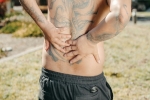Home »
Blog » Pain Management
| Stem Cell, PRP, Acupuncture in Queens & Long Island, New York
Pain Management | Stem Cell, PRP, Acupuncture in Queens & Long Island, New York
For persistent pain that is not alleviated with non-surgical treatment and activity modification, surgical removal of all or a portion of the coccyx (coccygectomy) is an option. There are varying suggestions in the medical literature regarding how long non-surgical treatments should be tried before surgery is recommended. Some believe a two-month course of non-surgical treatment is sufficient, while others suggest non-surgical treatment should be tried for between three and eight months before surgery is advisable.
Read more
Many studies find that non-surgical treatments are successful in approximately 90% of coccydynia cases. Treatments for coccydynia are usually noninvasive and include activity modification. Self-Care Treatment for Coccyx Pain Relief - The first line of treatment typically includes self-care that can be done without the assistance of a medical professional, such as some of the following...
Read more
Coccydynia is typically diagnosed by gathering a thorough medical history and completing a physical exam. These two standard diagnostic practices are usually sufficient in obtaining a diagnosis and evaluating treatment options, but in some cases, diagnostic tests such as scans or injections may be used.
Read more
Direct trauma to the tailbone is the most common cause of coccydynia and usually leads to inflammation surrounding the coccyx, which contributes to pain and discomfort. There are many cases reported in which pain begins with no identifiable origin (called idiopathic coccydynia).
Read more
Tailbone pain is usually accompanied by other, more specific symptoms that can sometimes indicate how pain is occurring. Common Symptoms of Coccydynia - Coccydynia may be further characterized by one or a combination of the following symptoms: Localized pain and tenderness - Pain is generally confined to the tailbone, and does not radiate through the pelvis...
Read more
Coccydynia refers to any persistent tailbone pain. The tailbone, located at the very bottom of the spine, is medically known as the coccyx. Coccydynia is typically felt as a localized pain that usually worsens when sitting or with any activity that puts pressure on the bottom of the spine.
Read more
The goal of medical treatments is to reduce pain, but these treatments do not change the underlying source of pain. A doctor will typically prescribe medical treatments alongside a physical therapy program or other regimen.
Read more
Many treatment options for low back pain can be tailored to an individual patient’s needs. Treatments include care administered at home, medicinal remedies, alternative care, or even surgery. Depending on the patient's diagnosis, some treatments may be more effective than others. Many people find that a combination of treatments is best.
Read more
Obtaining an accurate diagnosis that identifies the underlying cause of the pain, and doesn’t just correlate to the symptoms, is important in guiding treatment. As a foundation of the diagnostic process, the patient provides a detailed description of symptoms and medical history. From this information, a doctor will usually have a general idea of the source of the patient’s pain.
Read more
Low back pain might begin as acute due to an injury but can become chronic. Managing pain appropriately at an early stage can help limit symptoms in both time and severity Identifying the symptoms and getting a diagnosis that pinpoints the underlying cause of the pain is the first step in obtaining effective pain relief.
Read more
Love this Post? Spread the World






















